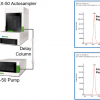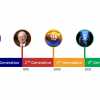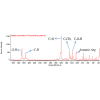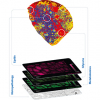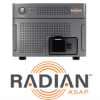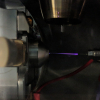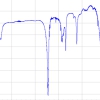R.S. Blake, P.S. Monks and A.M. Ellis
Department of Chemistry, University of Leicester, University Road, Leicester LE1 7RH, UK. E-mail: [email protected]
We are all familiar with the common constituents of air, such as nitrogen, oxygen, carbon dioxide and water vapour. However, air is actually a complex mixture consisting of a wide variety of inorganic and organic molecules derived from a multitude of sources. The organic content of air often gets overlooked, largely because it is present at levels of less than 1 part per million by volume (ppmv), and for many individual compounds the abundance is well under 1 part in a billion (ppbv). One might conclude that such low levels are unimportant, but this would be wrong. Reasons for wanting to determine the concentrations of specific volatile organic compounds (VOCs) in air include their role in reactive chemistry such as air pollution, determination of emission inventories of both natural and man-made sources of VOCs for modelling and policy control reasons, and to identify VOCs that may be toxic to humans even at low concentrations.
There are other specific reasons why the detection of VOCs is important. Each one of us is a perfect illustration of this point. Every time we breathe out we expel not only N2, O2, CO2 and H2O, but also a multitude of organic compounds. Some of those VOCs in exhaled breath may simply have been in the room at the time the breath was inhaled. However, other VOCs are by-products of our body chemistry and derive from the exchange between blood VOCs and the air inside our lungs. The presence of certain VOCs in breath has the potential to provide information leading to the prognosis or diagnosis of certain diseases. The ability to detect and discriminate a multitude of trace-level VOCs may therefore provide a means for creating a rapid medical screening device. The detection of VOCs shows promise in a variety of other areas, including the automated monitoring and optimisation of industrial processes, security applications (explosives, drugs), forensic science, automotive emissions and in establishing the origin and quality of foods.
Given the many reasons for wanting to detect and quantify VOCs in air, we need the tools to do this. The classic technique, and one which has been around for many decades, is gas chromatography and its variants, such as gas chromatography-mass spectrometry (GC-MS). The great strength of GC-MS in particular is its ability, through both chromatographic separation and mass spectrometry of the eluted fractions from the column, to provide reliable compound identification, as well as quantification. However, this comes at a cost, namely speed of data acquisition. The elution process through the column takes time, but there is the added problem that GC-MS lacks the sensitivity to detect most VOCs in air, unless some sort of pre-concentration process is employed. Pre-concentration requires continuous collection of the desired compounds onto some appropriate absorbing material or in a trap of some kind, in order to build up a satisfactory quantity for subsequent analysis. The pre-concentrated material is then injected into the column, usually by rapid heating. The combination of a pre-concentration step and then a relatively slow elution process through the column means that each measurement typically takes several minutes to complete, if not longer. This makes GC-MS an excellent analytical tool but it is not suitable for rapid monitoring of VOCs in a range of applications. This is where proton transfer reaction mass spectrometry, or PTR-MS, comes into its own.
The basics of PTR-MS
PTR-MS combines several ideas into a highly effective instrument for rapid and quantitative VOC detection.1,2 Ion production is via chemical ionisation, and in particular proton transfer to molecules in the analyte. The most commonly used reagent for this purpose is H3O+, which can be generated from water vapour using energetic ion sources, such as an electrical discharge1 or a radioactive source.3 Importantly, H3O+ can be generated with efficiencies approaching 100% in carefully designed ion sources.
Having generated the H3O+, proton transfer to a molecule, M, in the analyte can take place:
M + H3O+ → MH+ + H2O
H3O+ will transfer a proton to most VOCs at a high (collision-limited) rate, with the exception of short chain alkanes and some small unsaturated hydrocarbons. However, the abundant inorganic molecules in air, such as N2, O2 and CO2, have unfavourable proton affinities and therefore thermodynamics dictates that no proton is transferred to these molecules from H3O+, even if they collide. Thus H3O+ is selective to VOCs and there is no interference from large background ion signals derived from the inorganic constituents of air. This is different from traditional mass spectrometry based on electron impact ionisation, which is non-selective and therefore suffers from large signals from the most abundant constituents that may obscure weaker features, such as contributions from VOCs.
As shown in Figure 1, in PTR-MS the H3O+ is mixed with the analyte gas, usually air from one source or another, in a drift tube. This drift tube is pumped at the far end to achieve a pressure on the order of 1 mbar, and hence the incoming gas flows along the tube. The drift tube also contains a series of electrodes which provide a uniform electric field that draws ions along the tube at velocities well in excess of the flow velocity of the air. This ensures that the ions undergo more violent collisions with neutral molecules than would otherwise be the case, a fact that helps prevent formation of significant quantities of clusters ions. Without this process, multiple ion clusters would form owing to the many collisions each ion makes with neutral molecules as it makes its way along the tube and this would substantially complicate the mass spectrum. The drift tube also provides a zone of well-defined reaction time, which is important in quantifying gases (see below).

A mass spectrometer of some sort is located at the end of the drift tube to detect any product ions. In the early days of PTR-MS, quadrupole mass spectrometers (QMS) were exclusively used and indeed they are still widely used today. More recently other types of mass spectrometers, most notably time-of-flight mass spectrometers (ToF-MS)4,5,6,7 and quadrupole ions traps,8,9,10 have been successfully employed in PTR-MS. The choice of mass spectrometer comes down to cost and user requirements: ToF-MS in particular has a much higher mass resolution than QMS, as well as the added benefit of providing the whole mass spectrum at essentially the same time. Consequently, if the aim is to monitor many different VOCs at the same time then a ToF-MS would be the mass spectrometer of choice.
From a kinetic analysis of the proton transfer reactions in a drift tube, a simple relationship can be derived which links measured ion signals, i, to the concentration of gas M in the analyte, i.e.
i(MH+)/i(H3O+) = kt[M]
Good estimates of the proton transfer rate coefficients, k, are available for many VOCs and the reaction time, t, in the drift tube can also be deduced. Thus, by simply measuring the relative ion count rates for MH+ and H3O+ detected by the mass spectrometer, the absolute concentration of compound M (shown as [M] in the equation above) in the original analyte can be determined. Several factors can undermine this approach to concentration determinations, including the role played by H3O+(H2O)n clusters, which react at different rates with specific VOCs when compared with H3O+. Thus in practice accurate quantitative measurements require calibration of the instrument.
PTR-MS therefore has the potential to identify VOCs and to do so quantitatively. Furthermore, the detection of individual VOCs at parts per trillion levels in seconds is realistic. This combination of capabilities makes PTR-MS a versatile and powerful analytical tool.
An illustrative application: VOCs in human breath
PTR-MS is now seeing applications in many areas of science and technology, and indeed the reach of the technique is spreading ever wider. Given space limitations, we address just one example here: the application of PTR-MS in a medical context, and particularly for investigating whether diagnosis of certain diseases is viable from sampling human breath. This is a very challenging area of research which is still in its early days. The VOCs detected in human breath may derive not only from the degree of “wellness” of an individual, but also from other factors such as diet and genetic variation. It is therefore unclear if detection of breath VOCs could be used for the screening of multiple diseases, or whether it will be restricted to certain niche situations.
The great strength of PTR-MS, and in particular those instruments based on ToF-MS, is that a multitude of VOCs can be monitored simultaneously in real time. Figure 2 shows a mass spectrum of a breath sample of a volunteer recorded using a PTR-ToF-MS instrument (see also Figure 3). The dominant peak in such a spectrum will always be the source ion, H3O+, but water vapour levels are high in breath and so H3O+(H2O)n clusters can reach a significant level even with the use of the accelerating electric field in the drift tube: the H3O+(H2O) signal in Figure 2 is clearly significant, although less than H3O+. The major organic ion in this mass spectrum arises from protonated acetone, at m/z 59, which is often the most abundant VOC detected in breath, as is the case for this particular individual. At lower intensities a multitude of organic compounds are detected, some of which are illustrated in the expanded spectrum in the upper-right of Figure 2. These include methanol, dimethyl sulphide and isoprene, but further expansion yields many other peaks at levels well above the background noise level.


This spectrum and others like it highlight a particular strength of PTR-MS in the context of breath analysis for medical diagnosis. Although not all peaks can necessarily be assigned to specific VOCs, this may not strictly be necessary. Instead, PTR-MS can provide a peak pattern—a fingerprint if you like—which may contain far more information than available by monitoring a single VOC. Thus, one can use a multitude of peaks, particularly through a multivariate statistical analysis, to search for combinations which may be sensitive to a particular disease. Clinical trials are essential here and so far only small-scale trials of this type have been attempted, but the early results seem promising.
Concluding remarks
PTR-MS is a relatively young analytical technique, first appearing in the mid-1990s through ground-breaking work by the group of Werner Lindinger in Innsbruck, Austria.1 Commercial suppliers have ensured that these instruments are available to a multitude of users and in the past 10 years or so there has been an explosion of interest in PTR-MS, with applications ranging from botany and medicine through to industrial process monitoring, security screening, environmental analysis and food science. Alongside this growing user base, improvements in detection sensitivity and compound discrimination continue to be achieved. Wherever there is a requirement for rapid on-line monitoring of a multitude of trace VOCs, PTR-MS could very well provide an appropriate solution.
References
- A. Hansel, A. Jordan, R. Holzinger, P. Prazeller, W. Vogel and W. Lindinger, “Proton transfer reaction mass spectrometry: on-line trace gas analysis at the ppb level”, Int. J. Mass Spectrom. Ion Proc. 149/150, 609 (1995). doi: 10.1016/0168-1176(95)04294-U
- R.S. Blake, P.S. Monks and A.M. Ellis, “Proton transfer reaction mass spectrometry”, Chem. Rev. 109, 861 (2009). doi: 10.1021/cr800364q
- D.R. Hanson, J. Greenberg, B.E. Henry and E. Kosciuch, “Proton transfer reaction mass spectrometry at high drift tube pressure”, Int. J. Mass Spectrom. 223, 507 (2003). doi: 10.1016/S1387-3806(02)00924-7
- R.S. Blake, C. Whyte, C.O. Hughes, A.M. Ellis and P.S. Monks, “Demonstration of proton-transfer reaction time-of-flight mass spectrometry for real-time analysis of trace volatile organic compounds”, Anal. Chem. 76, 3841 (2004). doi: 10.1021/ac0498260
- C.J. Ennis, J.C. Reynolds, B.J. Keely and L.J. Carpenter, “A hollow cathode proton transfer reaction time of flight mass spectrometer”, Int. J. Mass Spectrom. 247, 72 (2005). doi: 10.1016/j.ijms.2005.09.008
- H. Tanimoto, N. Aoki, S. Inomata, J. Hirokawa and Y. Sadanaga, “Development of a PTR-TOFMS instrument for real-time measurements of volatile organic compounds in air”, Int. J. Mass Spectrom. 263, 1 (2007). doi: 10.1016/j.ijms.2007.01.009
- A. Jordan, S. Haidacher, G. Hanel, E. Hartungen, L. Märk, H. Seehauser, R. Schottkowsky, P. Sulzer and T.D. Märk, “A high resolution and high sensitivity proton-transfer-reaction time-of-flight mass spectrometer (PTR-TOF-MS)”, Int. J. Mass Spectrom. 286, 122 (2009). doi: 10.1016/j.ijms.2009.07.005
- P. Prazeller, P.T. Palmer, E. Boscaini, T. Jobson and M. Alexander, “Proton transfer reaction ion trap mass spectrometer”, Rapid Commun. Mass Spectrom. 17, 1593 (2003). doi: 10.1002/rcm.1088
- C. Warneke, J.A. de Gouw, E.R. Lovejoy, P.C. Murphy, W.C. Kuster and R. Fall, “Development of proton-transfer ion trap-mass spectrometry: on-line detection and identification of volatile organic compounds in air”, J. Am. Soc. Mass Spectrom. 16, 1316 (2005). doi: 10.1016/j.jasms.2005.03.025
- M.M.L. Steeghs, C. Sikkens, E. Crespo, S.M. Cristescu and F.J.M. Harren, “Development of a proton-transfer reaction ion trap mass spectrometer: Online detection and analysis of volatile organic compounds”, Int. J. Mass Spectrom. 262, 16 (2007). doi: 10.1016/j.ijms.2006.09.031




